Etruscan Architecture › Volsinii » Ancient origins
Articles and Definitions › Contents
- Etruscan Architecture › Antique Origins
- Volsinii › Ancient History
Ancient civilizations › Historical and archaeological sites
Etruscan Architecture › Antique Origins
Definition and Origins
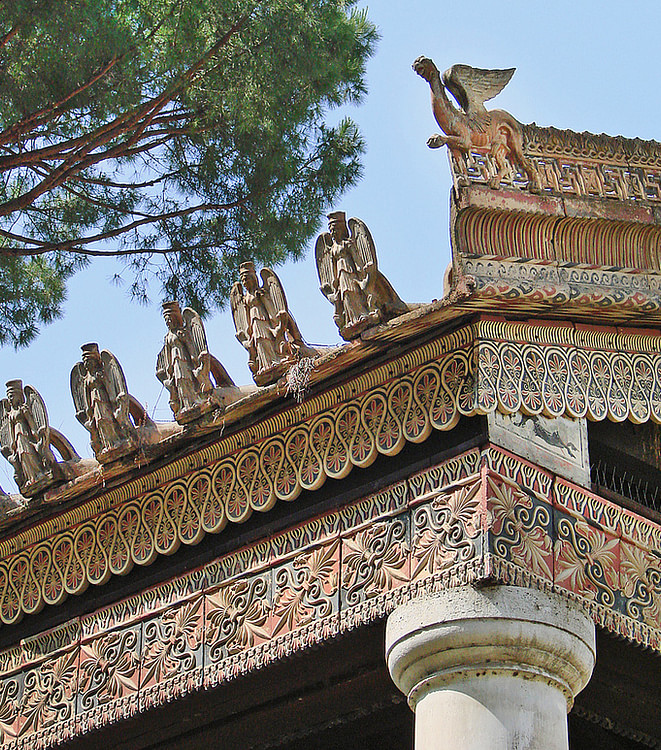
The architecture of the Etruscan civilization, which flourished in central Italy from the 8th to 3rd century BCE, has largely been obliterated both by the conquering Romans and time, but the very influence of the Etruscans on Roman architectureand the impression their buildings made on later writers give tantalising clues as to what we are missing. Pottery models, tomb paintings, and excavations at such sites as Tarquinia, Vulci, Veii, and Cerveteri have revealed tangible evidence that Etruscan architects were both innovative and ambitious. The Tuscan column, arched gate, private villa with atrium, and large-scale temples on impressive raised platforms with extravagant terracotta decorations are just some of the innovations that would be copied and adapted by their cultural successors in Italy.
PROBLEMS OF RECONSTRUCTION
Unfortunately, reconstructing the towns and buildings of the Etruscans is made difficult by the absence of any substantial remains. There is, alas, no Parthenon or Pompeii for this long and influential civilization. In addition, a great number of Etruscan towns were completely covered by later cities in the medieval and modern periods, making any excavations today either problematic or impossible. Other sources of information are required, and fortunately, the Etruscans themselves are able to provide it in their depictions of architecture in tomb paintings and pottery vessels made in the form of buildings from primitive huts to large temples. Roman writers, too, have contributed to our greater knowledge of Etruscan architecture through their admiring descriptions. Finally, one area where no texts or reconstructions are needed are the thousands of surviving tombs the Etruscans built, which evolved over the centuries from tumuli to grand stone-vaulted chambers housing multiple generations of the dead.
FROM THE MID-6TH CENTURY BCE, LARGER PRIVATE BUILDINGS HAD GABLED ROOFS SUPPORTED BY COLUMNS & AN ATRIUM, CREATING A COURTYARD OPEN TO THE SKIES.
ETRUSCAN HOUSING
Although Etruscan tombs were seemingly built to last for centuries using stone or rock-cut chambers, everyday domestic architecture was built from more perishable materials: wood, sun-dried mud brick, or waddle and daub for the walls. Examples of the 7th-6th-century BCE circular and oval huts at Acquarossa show that the walls there once had a plaster covering.Wooden poles provided additional support and held up a thatch roof. Stone was sometimes used for foundations and lower levels, though. As with larger public buildings, the roofs of houses may have been decorated with terracotta additions such as palmettes, lotus motifs, and figurines. Saddle tiles of the same material protected the apex of the roof of rectangular buildings, while examples of a centre tile with a hole in it survive from round structures, made to either admit light or allow smoke to escape. Such a tile from Acquarossa came with a disc cover to close the hole in case of rain. Beams were protected by nailing terracotta plaques to the exposed ends. Eventually, roof tiles would replace thatch.

Etruscan Model House
From the early 6th century BCE houses have multiple intercommunicating rooms, sometimes with a hall and a private courtyard. These still have only one floor. Excavations show that early communities had some basic form of planning with several houses arranged around a shared courtyard. This was also advantageous for the construction of rock-cut drainage channels placed between houses, which led off to cisterns, although, in some towns, the further from the centre, the more haphazard the placement of buildings.
From the mid-6th century BCE larger private buildings, probably influenced by the architecture of Asia Minor and Phoenicia, had gabled roofs supported by columns. They had an atrium, an entrance hall open to the sky in the centre and with a shallow basin on the floor in the middle for collecting rainwater. Opposite was a large room with a hearth and cistern and side rooms including accommodation for servants.

Etruscan Model House
Early Etruscan settlements were constructed on easily defended plateaus and ridges, but those towns located in places considered vulnerable to attack were further protected by stone walls and ditches. The settlement at Marzabotto is a good example of town planning with the 5th century BCE buildings oriented on a north-south axis and set in a grid pattern. We know that the Etruscans were particularly concerned with rituals and rites connected to planning and the layout of buildings and considered certain arrangements auspicious.
ETRUSCAN TEMPLES
The earliest Etruscan sacred spaces had no architecture to speak of, merely being an outdoor area defined as sacred with an altar where rites were performed. Some areas had a rectangular podium from where omens could be observed. Over time, buildings, probably only of wood and thatch, were erected within the sacred space, which had a variety of functions, including accommodation. The first Etruscan stone temple appears at Veii c. 600 BCE. That secondary buildings were also constructed in stone then is attested by the 6th-century BCE altar platform at Cortona. Measuring 5 x 6.5 metres and reaching a height of 2 metres, the altar is approached by a flight of 10 steps with balustrades. Such secondary buildings and the sacred area itself were often enclosed by a low rubble wall punctuated by occasional supports of cut blocks or even an entire outer facing of dressed stone.
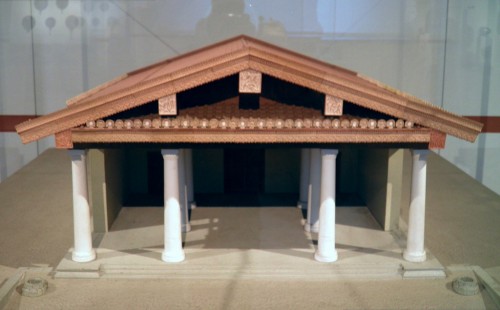
Etruscan Temple Model
Etruscan temple architecture has been difficult to reconstruct because of the lack of surviving examples. The Roman architect and writer Vitruvius describes a distinct 'Tuscan temple' with a columned portico and three small chambers at the rear interior, but evidence points to a more varied reality even if some basic features are common. Temples are almost square, unlike the obviously rectangular Greek temples, and placed on a much higher platform. Columns are known as the Tuscan type and, like the Doric order, they have no flutes but they do stand on a base. These support the roof which overhangs the entrance creating a deep porch.
One of the best-documented Etruscan temples is the c. 510 BCE Portonaccio Temple at Veii. It was built on an almost square base of volcanic tufa blocks measuring 18.5 m along the sides. With a front stepped-entrance, columned veranda, side entrance, and three-part cella, it does match Vitruvius' description. The roof was decorated with brightly painted life-size figure sculpture made in terracotta, a figure of a striding Apollo survives. Antefixes on the eves, again in terracotta, represented Maenads and Gorgons. The temple was perhaps dedicated to Menrva (the Etruscan version of Athena / Minerva ). Other sites with similar large temples include Pyrgi (Temples A and B) – one of the three ports of Cerveteri, Tarquinia (the Ara della Regina) and Vulci (the Great Temple). As in Greek temples, the actual altar and place of religious ceremonies remained outside the temple itself.
ETRUSCAN TOMBS
Simple stone cavities cut into the ground, with a jar of the deceased's ashes and a few daily objects placed in them, gave way to larger stone tombs enclosed in tumuli and, even later, free-standing buildings often set in orderly rows. These latter 7th-5th-century tumuli and block tombs had more impressive goods buried with the uncremated remains of the dead such as jewellery, dinner service sets, and even chariots.

Tomb of the Chariots, Populonia
Tumuli are made from a circular tufa block base and lower courses arranged in a circle. Alternatively, they are cut from existing rock at the chosen site. These low walls can have simple moulded decoration. A stone corridor leads to a central chamber, which is made to resemble a house with painted windows and door, or in the case of the earliest, with its low ceiling painted to imitate tent fabric and thus the even earlier Etruscan practice of burying the dead in tents. Some corridors and chambers have corbelled roofs such as the 7th-century BCE tomb at Volterra with its domed roof created by ever-decreasing rings of small stone blocks. Drainage was provided by either sloping stone slabs placed across the roof or building the whole tomb on a sloping stone base as seen in the Tomb of the Chariots at Populonia. The whole structure was then covered with a mound of earth. Some of the largest tumuli, such as at Cerveteri, measure up to 40 metres in diameter. Many of these tombs were in use over several generations.
A new type of tomb appeared from the 6th century BCE, the small free-standing block with gabled roof. These cube-like structures are best seen in the Banditaccia necropolis of Cerveteri. They are built using large stone blocks and, again, can incorporate natural rock at the site; each has a single doorway entrance and inside are stone benches on which the deceased were laid, carved altars, and sometimes stone seats. Set in rows, the tombs perhaps indicate a greater concern with town planning at that time.
Etruscan tombs from the Hellenistic period evolve into two new designs, best seen at Chiusi. One type is constructed from well-cut blocks and has a barrel vault much like Macedonian tombs. The second type has a much more impressive entrance tunnel; some are up to 25 metres in length. The interiors, conversely, are plainer with a simple rectangular or cross-shaped chamber lined with benches and niches on which were placed funerary jars and sarcophagi. These tombs were used over several generations, too, and in some cases, the entrance tunnels became the tomb itself with no end chamber built; one example has 39 niches for placing remains.
The walls of the tombs of the Etruscan elite were painted with colourful and lively scenes from mythology, religious practices, and Etruscan daily life, especially banquets and dancing. Architectural features are present framing such scenes or are even depicted in them. Tombs frequently have a painted door and frame, for example, as a metaphor for the deceased's passage into the next life. Other features appearing in paint include windows and columns and these are helpful in substantiating archaeological excavations of real buildings.
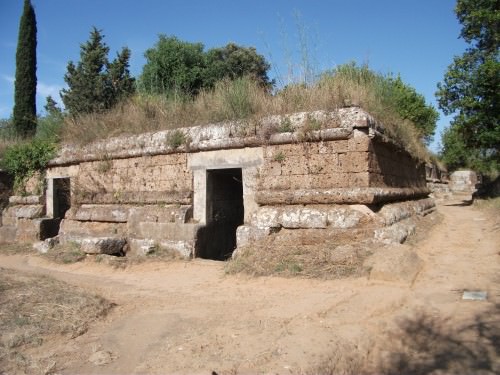
Etruscan Square Tomb, Cerveteri
LEGACY
The vaulted ceilings, arches, Tuscan column, and monumental city gates of Etruscan architecture would influence and inspire later Roman architects. Indeed, Etruscan builders were responsible for Rome 's most important early temple, that of the 6th-century BCE Jupiter Optimus Maximus on the Capitoline Hill. Etruscan arched gates would be, as with so many other areas of Roman design, made much grander and ostentatious, eventually morphing into the triumphal arch. The Etruscan use of tombs from the Hellenistic period to inter a large number of remains would influence the Romans in their later columbariawhere hundreds of remains would be neatly entombed on multiple levels. Finally, the atrium house design was adopted and adapted by the Romans, too, who gave it the name atrium tuscanicum in acknowledgement of their architectural debt to the Etruscans.
Volsinii › Ancient History
Definition and Origins

Volsinii (modern Orvieto ), located in central Italy, was an important Etruscan town from the 8th century BCE when it was known by the name of Velzna. Representatives of the Etruscan League met annually at the site in the most important Etruscan festival at the Fanum Voltumnae sanctuary. Volsinii was destroyed by the Romans in the 3rd century BCE, and the remaining population relocated to a new settlement nearby, modern Bolsena.
EARLY SETTLEMENT
Volsinii was a Villanovan settlement of over 100 ha, making it amongst the biggest of the Villanovan culture which was a precursor to the Etruscans, flourishing between 1100 and 750 BCE during the Iron Age of central Italy. The settlement was split into two parts located at either end of the acropolis. The town prospered due to its fertile agricultural lands in the Paglia valley and proximity to the middle Tiber river allowing it to trade with neighbouring sites. Most of the cemeteries of this period were dug out and built over in later times so that little remains have been found besides pottery sherds.
A THRIVING ETRUSCAN TOWN
Volsinii continued to prosper from the 7th century BCE onwards as indicated by the large number of family tombs built at the site. Black-figure pottery was produced at Volsinii but is of unremarkable quality. Sculptors worked using the local volcanic tufa stone, and several statues have been excavated at the site. Volsinii was a noted manufacturing centre for buccheropottery and bronze works, notably tools and lamps, several examples of which have survived. Trade and cultural links with the wider Mediterranean world are attested by imports, especially Attic pottery in the 6th and 5th century BCE. The town also produced its own coinage, stamped with the inscription Velzna. Finally, one more indicator of Volsinii's prosperity is the inscriptions which indicate the town founded several colonies in northern territories.
ETRUSCAN LEADERS MET ANNUALLY AT THE FANUM VOLTUMNAE SANCTUARY OF VOLSINII TO DISCUSS POLICY & ELECT A PRESIDENT.
Despite the flourishing of the city, this period was not an entirely peaceful one as the construction of around 7 km of fortification walls illustrates. The Etruscan towns often fought each other as they grew larger and an increase in population required more resources. The 4th-century BCE Francois Tomb at Vulci has a celebrated wall painting showing men of that town in battle with fellow Etruscans from Volsinii and Sovana.
THE FANUM VOLTUMNAE
Volsinii may have been a member of the Etruscan League, a loose confederacy of 12 (or perhaps 15) Etruscan towns. They included Cerveteri, Chiusi, Populonia, Tarquinia, Vulci, and Volterra. Very little is known of this league except that its members had common religious ties and that leaders met annually at the Fanum Voltumnae sanctuary to discuss policy and elect a president, the sacerdos Etruriae. The sanctuary was sacred to the god or goddess Veltha (Voltumna), a deity connected to vegetation and war. The exact location of the sanctuary is not known, but most historians consider the area around Orvieto as the best candidate. The annual festival, which attracted visitors from Etruria and beyond, included games, music, and a fair, but as most participants would have camped outside the city, the site location is unlikely to be ever determined with certainty.
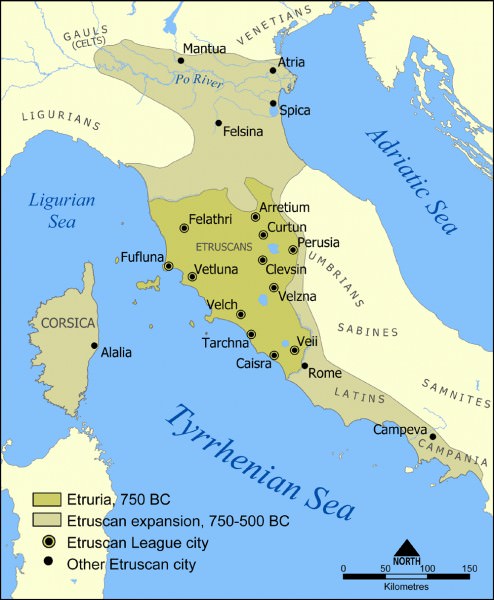
Etruscan Civilization
RELATIONS WITH ROME & DECLINE
Volsinii's status as an important regional town was threatened by the growing stature of its southern neighbour Rome. Rome was on the warpath and made repeated incursions into Etruscan territory; Veii was famously sacked in 396 BCE after a 10-year siege. Volsinii, not coming to the aid of her sister Etruscan cities, then inexplicably attacked Rome in 394 BCE, along with their ally Sappinum. The expedition was a disaster, and 8,000 Etruscan warriors were captured. Worse was to come a century later when the lands around Volsinii were ravaged. The town attempted to defend its interests but was badly defeated by a Roman army led by the consul Lucius Postumius Megellus, with 2,800 Etruscan warriors killed. Rusellae (modern Roselle) was then sacked in 294 BCE, a stark warning of the futility of opposing Rome. According to Livy, the Etruscan towns of Volsinii, Perusia, and Arretium then negotiated a peace with Rome. The price for a 40-year truce was a huge 500,000 asses per city.
In the event, the truce did not last very long as, in 284 BCE, Volsinii took advantage of an invading army of Gauls to join them and attack Arezzo (Arretium), an Etruscan city loyal to Rome. A relieving Roman army was defeated, but the next year the Romans, led by P. Cornelius Dolabella, won a decisive victory at the Battle of Lake Vadimo. Volsinii was attacked in 280 BCE, along with several other Etruscan cities. The Romans were proving insistent and lethal enemies.
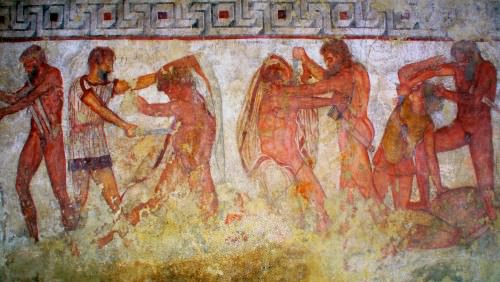
Battle Scene, Francois Tomb, Vulci
In 264 BCE, Volsinii became one of the last Etruscan cities to fall in the interminable wars with Rome. The aristocratic citizens of Volsinii called for Roman assistance in quashing an internal popular (and slave) revolt but got rather more than they bargained for when the Romans attacked and destroyed the town after a lengthy siege. Survivors were forcibly relocated to nearby Bolsena, a much less defensible location, which was then given the Roman name of Volsinii Novi. Roman writers describe the total destruction of Volsinii and the confiscation of over 2,000 bronze statues, to be melted down for coinage.Archaeological remains at Volsinii Novi include a forum and the foundations of several domestic houses. The original Volsinii would rise again, though. Indeed, its necropolis and associated sanctuary remained in use well into the Roman period, as did the Voltumnae Games, and Volsinii/Orvieto later became an important medieval town. It is the architecture of this period which is visible at the site today, still impressively sited on the natural acropolis where Volsinii once stood.
ARCHAEOLOGICAL REMAINS
Precisely because the Romans destroyed the settlement and the present town sits directly on top of it, there are scant archaeological remains dating to the Etruscan period. There are remains of the so-called Belvedere Temple, a late 5th-century BCE temple to an unknown deity (although one inscribed votive offering suggests Tin, the supreme deity of the Etruscan pantheon ). The building was constructed on a tufa block platform and had the typical design elements common to many Etruscan temples with a collonaded and extended front porch (with two rows of four columns), a three-room inner cella, and surrounding sacred enclosure. The temple measured 16.9 x 21.91 metres. Terracotta figures from the temple are on display in Orvieto's archaeological museum. Although fragmentary, one group, according to the historian NJ Spivey, may represent Greek heroes drawing lots to see who would fight Hector during the Trojan War.
There are remains of at least seven more temples at Volsinii. One of these, we know from Roman sources, was dedicated to Nortia, a deity linked with Menerva and possibly fate. A ritual at her temple was to annually hammer a nail into the building to fix the fates for that year. Later, the custom was used to see off plagues and disasters.

Etruscan Tombs, Volsinii
Small square tombs with corbelled roofs were laid out in regular grid patterns along streets in the Crocifisso del Tufo necropolis. Each tomb is topped by an earth mound (but not covered) and stone grave markers. Many tombs have an inscription on the lintel of their single doorways which indicate the tomb's principal occupant. From these inscriptions, historians estimate there were some 90 wealthy families at Volsinii in the latter half of the 6th and then 5th century BCE. Many names are of non-Etruscan origin (Umbrian, Celt, Sabine, etc.) highlighting the cosmopolitan nature of the town at its height and its role as a hub of trade and cultural exchange. Some tombs have painted interiors showing scenes of daily life and especially banquets. A second and similar necropolis is under excavation to the south of the settlement at Cannicella and includes a 5th-century BCE square temple with two cellas.
Surviving Etruscan artworks from Volsinii include a half life-size statue of Aphrodite (?) from the sanctuary at the Cannicella necropolis. It dates to c. 520 BCE and once wore earrings, a necklace, and diadem, presumably in a precious metal but now lost. There is the 5th-century BCE bearded head of a god from the San Leonardo Temple, probably a representation of Tin.Finally, one of the finest surviving bronze figurines produced by the Etruscans, the Mars of Todi, is attributed to Volsinii. Dating to the early 4th century BCE, the striking figure wears a cuirass and once held a lance. The figure is 142 cm tall and was discovered ritually buried in a stone-lined trench after having been struck by lightning. It is now on display in the Vatican Museums in Rome.
MAP
LICENSE:
Article based on information obtained from these sources:with permission from the Website Ancient History Encyclopedia
Content is available under License Creative Commons: Attribution-NonCommercial-ShareAlike 3.0 Unported. CC-BY-NC-SA License